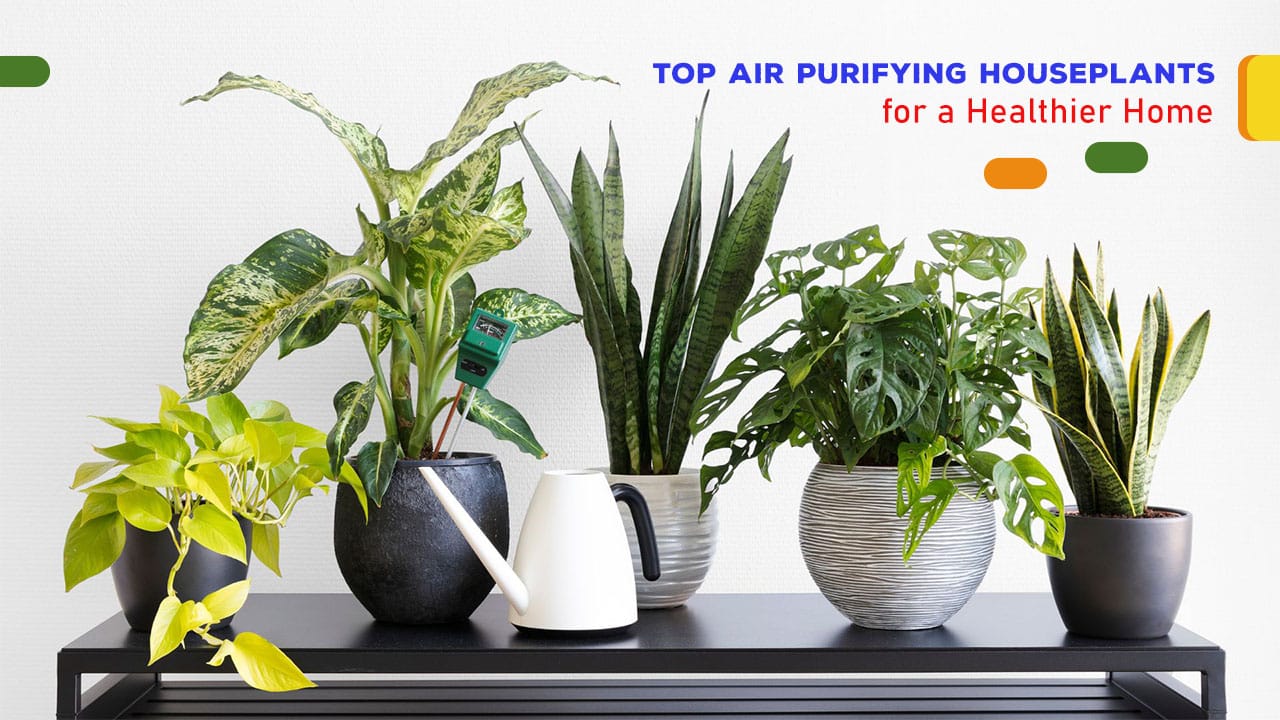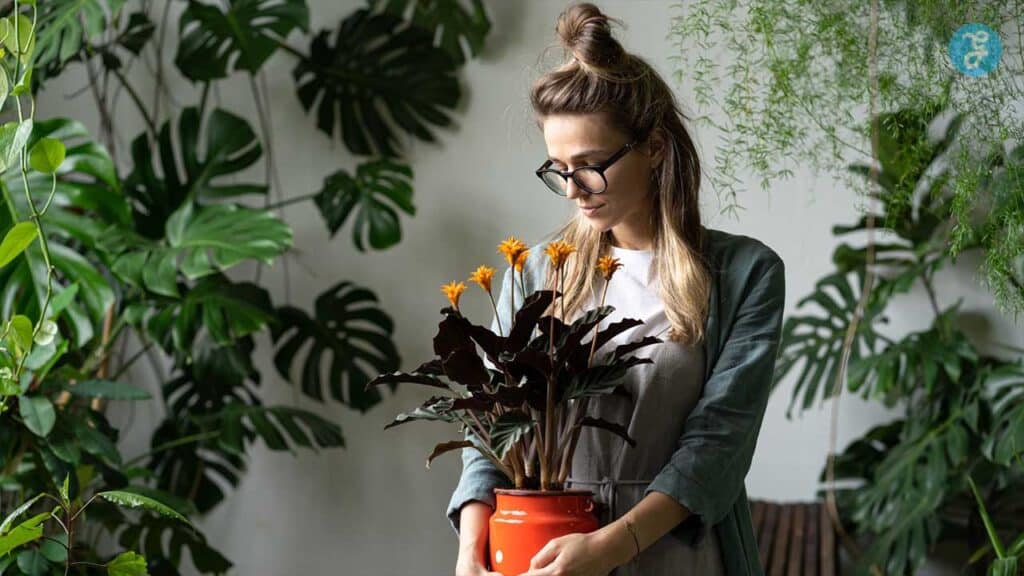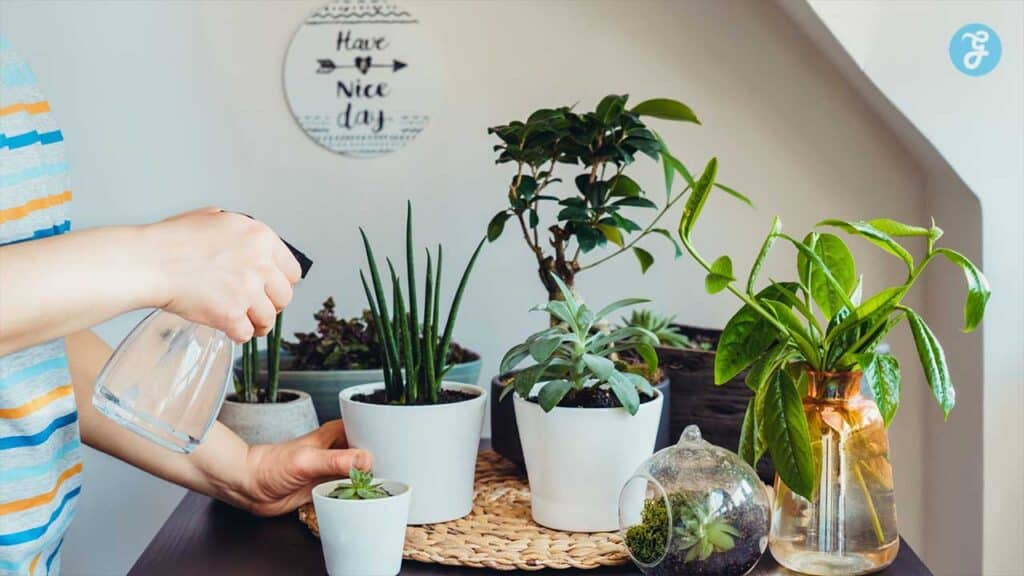Tired of breathing stale indoor air? You’re not alone. Many people want cleaner, fresher air at home. Plants can help. Some houseplants are great at removing toxins and improving air quality.
Adding air-purifying plants to your home can boost your health and well-being. These green helpers work quietly in the background, cleaning the air you breathe every day.
Let’s look at 10 top plants that can make your home healthier and more inviting.
1. Peace Lily
Peace lilies are great air-purifying plants for your home. They can help clean the air you breathe. These plants have dark green leaves and white flowers that look nice in any room.
Peace lilies can remove harmful chemicals from the air. They’re good at getting rid of things like formaldehyde and benzene. These chemicals can come from furniture, carpets, and cleaning products.
You don’t need a green thumb to grow peace lilies. They’re easy to care for and don’t need much light. Just water them when the soil feels dry. Too much water can hurt them, so be careful not to overwater.
Peace lilies like warm spots in your house. Keep them away from cold drafts. They do well in bathrooms because they like humidity. You can also mist their leaves to keep them happy.
These plants are toxic if eaten. Keep them away from pets and small children. Wash your hands after touching the plant to be safe.
2. Snake Plant
Snake plants are tough and easy to grow. You’ll love how they can clean the air in your home. These plants have tall, upright leaves that look like swords.
Snake plants remove harmful chemicals from the air. They take out things like formaldehyde and benzene. This helps make your indoor air cleaner to breathe.
You can put snake plants almost anywhere in your house. They do well in low light and don’t need much water. This makes them great for beginners or busy people.
Snake plants keep working at night too. While you sleep, they release oxygen. This can help you breathe better and sleep more soundly.
These plants are hard to kill. They can survive if you forget to water them sometimes. Just don’t give them too much water, as this can harm their roots.
Snake plants come in different sizes. You can find small ones for your desk or big ones for the floor. Their green and yellow striped leaves add a nice look to any room.
3. English Ivy
English ivy is a top pick for cleaning indoor air. This plant removes harmful chemicals like benzene from your home. It works fast too. In just 24 hours, it can get rid of almost 90% of benzene in the air.
You’ll love how easy English ivy is to grow. It does well in both bright and low light areas. This makes it perfect for any room in your house.
English ivy looks great in hanging baskets or pots. It has a climbing nature, so you can let it trail down or grow up a tree. This adds a nice touch to your decor.
Be careful where you place English ivy outdoors. It can spread quickly and take over other plants. But inside, it’s a great choice for cleaner air and a prettier home.
Remember to keep English ivy away from pets and kids. The leaves can be harmful if eaten. With proper care, this plant will help you breathe easier and add beauty to your space.
4. Boston Fern
Boston ferns are excellent air purifiers for your home. These lush, green plants have feathery fronds that add a touch of elegance to any room. They’re especially good at removing formaldehyde from the air.
You’ll find Boston ferns easy to care for. They prefer bright, indirect light and moist soil. Keep them away from direct sunlight to prevent leaf burn.
These ferns thrive in humid environments. You can increase humidity by misting them regularly or placing them on a pebble tray filled with water. This helps keep their leaves fresh and vibrant.
Boston ferns are non-toxic to pets and children, making them a safe choice for any household. They grow well in hanging baskets or on plant stands, allowing their fronds to cascade beautifully.
To keep your Boston fern healthy, trim away any brown or yellow leaves. This encourages new growth and keeps the plant looking its best. With proper care, these ferns can grow quite large and become a stunning focal point in your home.
5. Areca Palm
Areca palms are top-notch air purifiers for your home. These elegant plants can remove harmful toxins from the air you breathe.
Areca palms excel at filtering out formaldehyde and benzene. These chemicals often lurk in household items and can be bad for your health.
You’ll love how areca palms add a tropical feel to any room. Their feathery fronds create a lush, green backdrop that’s hard to beat.
These plants work hard to clean your air day and night. A single areca palm can remove up to a quart of indoor air pollutants in just 24 hours.
Areca palms also boost humidity. This is great for dry indoor spaces, especially in winter when heating systems can dry out the air.
You’ll find areca palms easy to care for. They like bright, indirect light and regular watering. Just make sure the soil drains well to keep your palm happy.
These plants grow pretty tall, so give them some space. They’re perfect for filling empty corners or creating natural room dividers.
Remember to dust the leaves now and then. Clean leaves are better at cleaning your air. Plus, it keeps your areca palm looking its best.
6. Aloe Vera
Aloe vera is a popular houseplant that can help clean the air in your home. This succulent is easy to care for and offers many benefits.
You’ll find aloe vera useful for more than just air purification. Its gel can soothe minor burns and skin irritations. Keep a plant in your kitchen for quick access when cooking accidents happen.
Aloe vera thrives in bright, indirect sunlight. Water it sparingly, allowing the soil to dry out between waterings. This plant is perfect for busy people or those new to plant care.
NASA studies have shown that aloe vera can remove formaldehyde from the air. This harmful chemical is found in many household products and building materials.
To get the most air-cleaning power, place your aloe vera in a spot with good airflow. A sunny windowsill in your living room or bedroom works well.
You can grow aloe vera in small pots, making it ideal for apartments or rooms with limited space. As it grows, you can divide the plant to create new ones for other areas of your home.
7. Spider Plant
Spider plants are easy to grow and excellent at purifying indoor air. These plants have long, thin leaves that arch outwards, giving them a spider-like appearance.
You’ll love how spider plants can remove harmful substances from your home. They’re especially good at getting rid of formaldehyde, which can come from furniture and carpets.
Spider plants are tough and can thrive in many conditions. You don’t need a green thumb to keep them alive. They do well in bright indirect light but can also handle lower light areas.
Want to fill your home with more spider plants? You’re in luck. These plants grow “babies” that dangle from the main plant. You can easily cut these off and plant them to start new spider plants.
Spider plants are safe for pets too. If you have cats or dogs, you don’t need to worry about them getting sick from nibbling on the leaves.
To care for your spider plant, water it when the soil feels dry. Don’t overwater, as this can harm the plant. Trim off any brown tips to keep it looking its best.
8. Bamboo Palm
The Bamboo Palm is a great choice for cleaner air in your home. This plant can grow quite tall, reaching up to 10 feet. But don’t worry – you can keep it shorter with pruning if you prefer.
Bamboo Palms are very good at filtering out harmful chemicals from the air. They’re especially effective at removing benzene and trichloroethylene. These are toxic substances that can be found in many homes.
You’ll find that Bamboo Palms are easy to care for. They do well in areas with indirect light. This makes them perfect for spaces that don’t get a lot of sun.
Another benefit of the Bamboo Palm is its ability to add moisture to the air. It acts as a natural humidifier, which can be great for your skin and respiratory health.
When choosing a spot for your Bamboo Palm, look for a corner or small area that needs some greenery. The plant’s elegant, feathery fronds will add a touch of tropical beauty to any room.
Remember to water your Bamboo Palm regularly. Keep the soil moist but not soggy. With proper care, this air-purifying plant will thrive and help keep your home’s air clean for years to come.
9. Rubber Plant
Rubber plants are great for purifying indoor air. These plants have big, shiny leaves that look nice in your home. They can grow tall, so you’ll need some space for them.
Rubber plants are good at removing harmful chemicals from the air. They can get rid of formaldehyde, which is found in many household items. This makes your air cleaner and safer to breathe.
These plants are pretty easy to care for. They like bright, indirect light and regular watering. Just make sure not to overwater them. Let the soil dry out a bit between waterings.
Rubber plants can grow quite large indoors. You can keep them smaller by pruning them regularly. This also helps them stay bushy and full.
If you have pets or small children, be careful with rubber plants. Their sap can cause skin irritation. It’s best to keep them out of reach.
Rubber plants not only clean your air but also add a touch of green to your space. They have a sleek, modern look that fits well in many home styles. With proper care, your rubber plant can be a long-lasting addition to your indoor garden.
10. Dracaena
Dracaena is a top choice for air purification in your home. This versatile plant comes in many varieties, making it easy to find one that fits your style.
Dracaenas are great at removing harmful chemicals from the air. They can help get rid of benzene, formaldehyde, and trichloroethylene. These are common pollutants found in many homes.
You’ll love how easy dracaenas are to care for. They don’t need much water and can thrive in low light. This makes them perfect for beginners or busy plant owners.
Dracaenas can grow quite tall, so they’re great for filling empty corners. Some popular types include the corn plant, dragon tree, and song of India.
To keep your dracaena healthy, place it in bright indirect light. Water it when the top inch of soil feels dry. Avoid overwatering, as this can cause root rot.
Dracaenas not only clean your air but also add a touch of greenery to your space. Their long, strappy leaves come in various shades of green, sometimes with yellow or red edges.
Benefits of Air Purifying Houseplants
Air purifying plants can make your home healthier and more pleasant. They clean the air and help you feel better.
Improving Indoor Air Quality
Plants can remove harmful chemicals from your air. They take in toxins like benzene and formaldehyde through their leaves. The peace lily is great at this. It gets rid of many bad chemicals.
Rubber plants also clean the air well. Their big leaves soak up formaldehyde. This makes your home safer to breathe in.
Some plants add moisture to the air too. The areca palm puts about a quart of water into the air each day. This can help if your home is dry.
Reducing Stress and Enhancing Mood
Having plants around can make you feel calmer. Their green color is soothing to look at. This can lower your stress levels.
Caring for plants gives you a fun hobby. Watching them grow can make you feel good. It’s rewarding to see your plants thrive.
Plants can make your home look nicer too. A rubber plant adds elegance to any room. Beautiful plants can lift your mood just by being there.
Care Tips for Air Purifying Houseplants
Taking care of air purifying plants is easy. With the right watering, light, and soil, your plants will thrive and clean your air.
Watering Guidelines
Don’t overwater your air purifying plants. Most need to dry out between waterings. Check the soil with your finger – if the top inch feels dry, it’s time to water. Use room temperature water and pour it slowly until it drains from the bottom. Empty the saucer so roots don’t sit in water.
For peace lilies and rubber plants, keep soil moist but not soggy. Palms like it a bit drier. Water less in winter when growth slows down. Mist leaves of tropical plants to boost humidity.
Lighting Requirements
Most air purifying plants do well in bright, indirect light. Place them near windows but out of direct sun. South or east-facing windows work great. Rotate plants every few weeks so all sides get light.
Peace lilies and snake plants can handle low light. Rubber plants and palms need brighter spots. If leaves look pale or growth is slow, move to a brighter area. Too much direct sun can burn leaves.
Soil and Potting Suggestions
Use well-draining potting mix for air purifying plants. Mix regular potting soil with perlite or sand to improve drainage. Repot every 1-2 years in spring. Choose pots 1-2 inches larger with drainage holes.
Don’t pack soil too tightly. Leave room for roots to grow. Add a layer of pebbles at the bottom of pots for better drainage. Top with fresh soil each spring. Fertilize monthly during growing season with balanced liquid fertilizer at half strength.
Common Challenges and Solutions
Growing air-purifying plants can be tricky at times. Let’s look at some common issues you might face and how to tackle them.
Pest Control and Prevention
Pests can harm your air-purifying plants. Keep an eye out for tiny bugs or webs on leaves. To prevent pests, wipe leaves with a damp cloth regularly. This removes dust and keeps pests away.
If you spot pests, act fast. Use neem oil spray or insecticidal soap. Apply it to affected areas. Repeat weekly until the pests are gone.
For serious infestations, you might need to isolate the plant. This stops pests from spreading to other plants.
Dealing with Overwatering
Overwatering is a common mistake. It can lead to root rot and kill your plant. To avoid this, check the soil before watering. Stick your finger about an inch into the soil. If it’s still moist, wait to water.
Use pots with drainage holes. This lets excess water escape. Empty saucers after watering to prevent standing water.
If you’ve overwatered, let the soil dry out completely. In severe cases, you might need to repot the plant in fresh, dry soil. Remove any mushy or black roots before repotting.
How to Arrange Houseplants for Maximum Effect?
Placing your air-purifying plants strategically can boost their impact on your indoor air quality. Here are some tips to help you arrange your green friends effectively:
Group plants together to create a mini indoor forest. This increases humidity and improves air circulation. Try placing 3-5 plants of different heights in a corner or near a window.
Put taller plants like peace lilies or rubber plants behind shorter ones. This creates visual interest and allows all plants to get enough light.
Use plant stands or shelves to add vertical interest. This helps maximize floor space while still showcasing your collection.
Place plants near pollution sources. Put a spider plant next to your printer or a snake plant near your cleaning supplies.
Don’t forget about bathrooms and kitchens. These rooms often have higher humidity, perfect for plants like ferns or pothos.
Rotate your plants regularly. This ensures all sides get equal light and keeps them growing evenly.
Consider these placement ideas:
- Living room: Group plants on a coffee table or bookshelf
- Bedroom: Place a lavender plant on your nightstand for better sleep
- Home office: Line up small plants along your desk for a productivity boost
Remember, each plant has unique light and water needs. Always check care instructions to keep your green friends thriving in their new spots.
Final Thoughts
Incorporating air-purifying houseplants into your home is a natural and effective way to enhance your indoor environment. These green companions not only beautify your living spaces but also work tirelessly to cleanse the air you breathe.
From the elegant peace lily to the robust snake plant, each species offers unique benefits in removing harmful toxins and improving air quality. By selecting a variety of these plants and providing them with proper care, you create a healthier, more vibrant home atmosphere.
Remember that nurturing these plants is a rewarding experience that goes beyond air purification – it’s about cultivating a connection with nature within your own four walls.
As you tend to your indoor garden, you’re not just improving your home’s air quality; you’re also fostering a sense of well-being and tranquility.
With a little attention and care, these leafy allies will thrive, transforming your living space into a fresher, more inviting sanctuary for you and your loved ones.








































